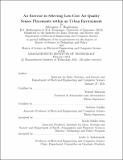| dc.contributor.advisor | Youssef Marzouk and Stefanie Jegelka. | en_US |
| dc.contributor.author | Boghozian, Adrianna J.(Adrianna Judith) | en_US |
| dc.contributor.other | Massachusetts Institute of Technology. Institute for Data, Systems, and Society. | en_US |
| dc.contributor.other | Technology and Policy Program. | en_US |
| dc.contributor.other | Massachusetts Institute of Technology. Department of Electrical Engineering and Computer Science. | en_US |
| dc.date.accessioned | 2021-05-24T20:24:03Z | |
| dc.date.available | 2021-05-24T20:24:03Z | |
| dc.date.copyright | 2021 | en_US |
| dc.date.issued | 2021 | en_US |
| dc.identifier.uri | https://hdl.handle.net/1721.1/130793 | |
| dc.description | Thesis: S.M. in Technology and Policy, Massachusetts Institute of Technology, School of Engineering, Institute for Data, Systems, and Society, Technology and Policy Program, February, 2021 | en_US |
| dc.description | Thesis: S.M., Massachusetts Institute of Technology, Department of Electrical Engineering and Computer Science, February, 2021 | en_US |
| dc.description | Cataloged from the official PDF of thesis. | en_US |
| dc.description | Includes bibliographical references (pages 69-75). | en_US |
| dc.description.abstract | Air pollution poses the most important environmental health risk to citizens of major cities all over the world. The high cost of current monitoring programs means that enforcement of current regulation, such as the United States Environmental Protection Agency's ambient air quality standards, can be lacking at the individual level. Because of their low cost, sensor networks offer the benefit of providing detailed, high resolution pollutant exposure maps which can inform a number of community and government initiatives aimed at tackling air pollution. The question then arises, what is the optimal configuration of low-cost sensors to measure air pollution within an urban environment? Due to the large number of potential locations in which to measure data, there are difficulties in defining where to place a limited number of sensors. This thesis outlines a proven decision method from spatial statistics: optimal experimental design, and applies the method to a test case in the city of London. | en_US |
| dc.description.statementofresponsibility | by Adrianna J. Boghozian. | en_US |
| dc.format.extent | 75 pages | en_US |
| dc.language.iso | eng | en_US |
| dc.publisher | Massachusetts Institute of Technology | en_US |
| dc.rights | MIT theses may be protected by copyright. Please reuse MIT thesis content according to the MIT Libraries Permissions Policy, which is available through the URL provided. | en_US |
| dc.rights.uri | http://dspace.mit.edu/handle/1721.1/7582 | en_US |
| dc.subject | Institute for Data, Systems, and Society. | en_US |
| dc.subject | Technology and Policy Program. | en_US |
| dc.subject | Electrical Engineering and Computer Science. | en_US |
| dc.title | An exercise in selecting low-cost air quality sensor placements within an urban environment | en_US |
| dc.type | Thesis | en_US |
| dc.description.degree | S.M. in Technology and Policy | en_US |
| dc.description.degree | S.M. | en_US |
| dc.contributor.department | Massachusetts Institute of Technology. Institute for Data, Systems, and Society | en_US |
| dc.contributor.department | Technology and Policy Program | en_US |
| dc.contributor.department | Massachusetts Institute of Technology. Department of Electrical Engineering and Computer Science | en_US |
| dc.contributor.department | Massachusetts Institute of Technology. Engineering Systems Division | |
| dc.identifier.oclc | 1252064693 | en_US |
| dc.description.collection | S.M.inTechnologyandPolicy Massachusetts Institute of Technology, School of Engineering, Institute for Data, Systems, and Society, Technology and Policy Program | en_US |
| dc.description.collection | S.M. Massachusetts Institute of Technology, Department of Electrical Engineering and Computer Science | en_US |
| dspace.imported | 2021-05-24T20:24:03Z | en_US |
| mit.thesis.degree | Master | en_US |
| mit.thesis.department | TPP | en_US |
| mit.thesis.department | ESD | en_US |
| mit.thesis.department | IDSS | en_US |
| mit.thesis.department | EECS | en_US |
